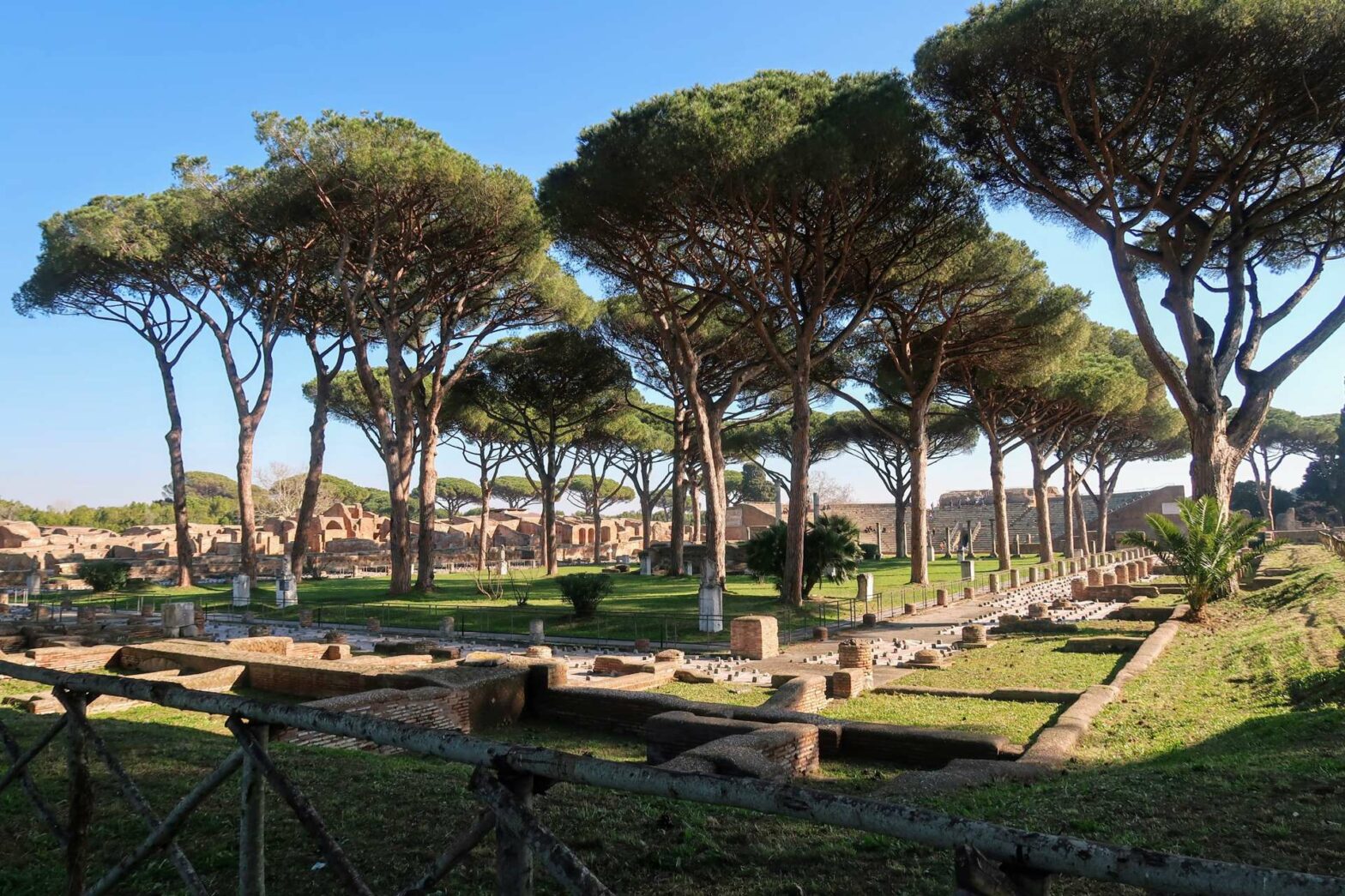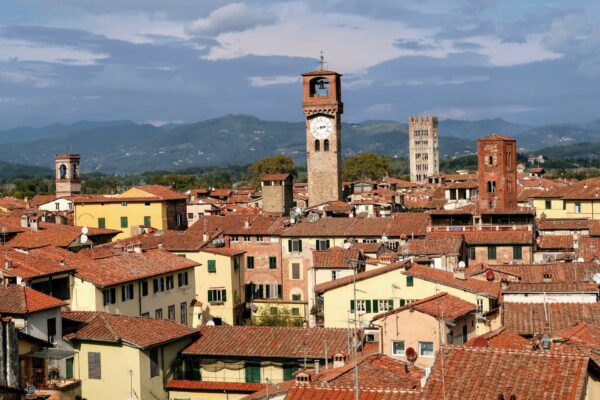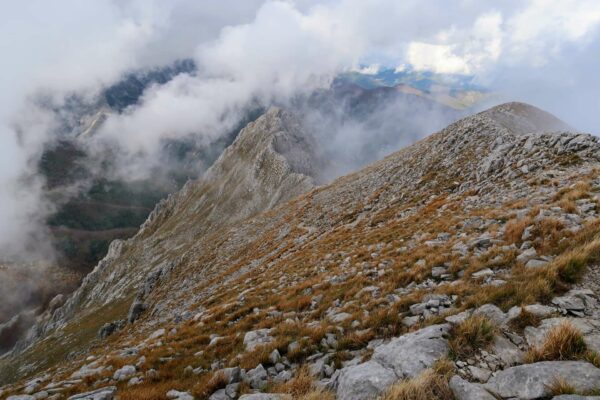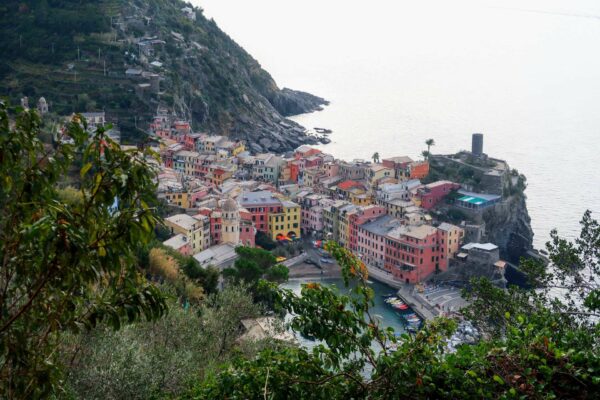By Vicky · Published Feb. 23rd, 2024
When you buy through links highlighted with an asterisk (*) on this site, we may earn a small affiliate commission at no cost to you.
This self-guided walking tour of Ostia Antica brings you to all the top sights in the ruins of this ancient harbour not far from Rome. It’s a great half-day trip; the ruins are rather spectacular and there are far fewer tourists/cars/pollution than in central Rome.
Page Contents:
How to get to Ostia Antica from Rome
The train is the best way to get to Ostia Antica from Rome. The train leaves from Roma Porta S. Paolo Train Station, opposite the Pyramid of Caius Cestius and the Protestant Cemetery. It’s also called the Rome-Lido Railway. To get to the train station you can either take the Metro (B Line) or any of several buses.
The train from Rome to Ostia Antica leaves every 22 minutes starting around 5:30 am and ending around 11 pm. The journey itself takes 26 minutes. If you’re using Google to navigate, it occasionally adds an extra train that doesn’t exist in between the trains spaced at 22 minutes. These ‘extra trains’ are a mistake.
The stop you want to get off at is simply called Ostia Antica. From here, clear signs direct you to the archaeological site and it’s a 10-minute walk. First, you have to walk under the railway to cross to the other side, then head across a bridge over a highway. Heading straight onward along a quiet street, you’ll soon reach the car park, ticket office, and the entrance to Ostia Antica.
How much does a train ticket from Rome to Ostia Antica cost?
The cost of the train from Rome to Ostia Antica is €1.50. It’s within Rome metropolitan area, where all journeys are €1.50 if completed within 100 minutes. If you take the bus to the train station, then the entire journey is still only €1.50. Just tap-and-go with your debit card both on the bus and at the gates to get into the train station. The return journey from Ostia Antica to Rome is then also €1.50.
Ostia Antica Walking Tour Map
Information for a Visit to Ostia Antica
Ostia Antica Tickets
Tickets to Ostia Antica cost €18/2 for adults/reductions (18-25 EU citizens) and are free for children. Audioguides are an extra €5/7 for a short/long version. It’s free (but crowded) on the first Sunday of the month. If you aren’t on a guided tour, audioguides are potentially worth it as otherwise all the ruined walls may look quite similar. However, there are enough information signs around the archaeological area that audioguides are not essential.
Tickets to Ostia Antica actually include all the sites managed by the Archaeological Park of Ostia Antica and are valid for 8 days from the first entry. These other sites include:
- Julius II Castle (5 minute’s walk from Ostia Antica entrance)
- Museum of the Roman Ships from Fiumicino (near Fiumicino airport)
- Imperial Harbours of Claudius and Trajan
- Necropolis of Portus in the Isola Sacra
If you haven’t got a car, the Imperial Harbour and Necropolis of Portus are difficult to reach. However, Julius II Castle is very close to the main Ostia Antica archaeological park, so it’s worth taking at least a short look. The Museum of Roman Ships from Fiumicino is very close to the airport of the same name. Since the tickets are valid for 8 days from first use, if you’re leaving a few days later from this airport you can visit the museum while waiting for your flight. From the airport, it’s a 20-minute walk or there’s a free shuttle bus every 30 minutes to the museum.
Ostia Antica Opening Hours
The historical site of Ostia Antica is open from Tuesday to Sunday. It opens at 8:30 am all year round and closes between 4:30 pm and 7 pm depending on the season. Check the Official Website for more information.
What to Wear to Ostia Antica
The most important thing to wear to Ostia Antica is comfortable shoes for walking. It’s a very large site, and the ground is mostly cobbles, ancient Roman roads, or dirt. Trainers (sneakers) are highly recommended. As for clothes, you are allowed to wear whatever you like (unlike some of the churches in Rome where you have to cover shoulders and knees). There’s not much shade, so it’s best to cover your shoulders anyway to avoid sunburn. Sunglasses and a sunhat are also recommended, and don’t forget the sunscreen either!
More Tips for Visiting Ostia Antica
- Picnics are not allowed, but there’s a good cafe inside, Café degli Scavi, which has reasonable prices and decent food. Take a water bottle and snacks to keep you going when walking around.
- Allow at least 3 hours, and up to 5 hours if you want to see everything at Ostia Antica.
- In winter, many of the floor mosaics are covered up so you can’t see them. However, a few are left uncovered.
- There are toilets at the entrance and at the cafe.
- Save the museum either for the hottest part of the day (mid-afternoon) or go there for a relatively cool break halfway around.
Top Things to See at Ostia Antica
On this self-guided walking tour of Ostia Antica, you’ll visit all the best things to see in this ancient harbour. These include:
- Decumanus Maximus
- Baths of Neptune Viewpoint
- Theatre
- Mithraeum of the Serpents
- Mill & Bakery
- Thermopolium
- Forum
- Ancient Toilet
- Terme del Foro
- Fishmongers’ Shops
- Terme dei Sette Sapienti
- House of Cupid & Psyche
- Jars in the ground
- Ostia Antica Museum
If you prefer, there’s a great guided tour of Ostia Antica* where you’ll be accompanied from Rome to the site and shown around by a knowledgeable guide.
Ostia Antica Self-Guided Walking Tour Route
This walking tour starts from the ticket office at Ostia Antica.
Directions: Head into the main archaeological site.
1. Decumanus Maximus
You’ll now be on Decumanus Maximus, the main street through Ostia Antica. The same name was given to one of the main streets in most Roman towns. Walking along this street, the first thing you’ll see is the necropolis, or city of the dead, on your left. There are many tombs here, and you can still see fine details on some of them. This cemetery is outside the city walls since the dead were not allowed to be buried inside.
You’ll soon come to the remains of an old gate, the Porta Romana, within what’s left of the walls. You’ll see the base of a marble arch support and a few other bits of marble cladding. Like elsewhere in Ostia Antica, there’s also an information board (in Italian and German) to explain more about what you’re looking at.
Most of the other main things to see in Ostia Antica can be reached directly from the Decumanus Maximus, and this walking tour follows it with a few deviations until the far end of the site before returning via the museum.
Directions: Head through the gate and about 250 metres later you’ll see a viewpoint up some steps on your right.
2. Baths of Neptune Viewpoint
The Baths of Neptune Viewpoint is the first of several on this walking tour of Ostia Antica. From the top of the steps, you can first see the large extent of the ancient ruins here. From this vantage point you can also see the many fine mosaics within the Baths complex. The grassy open area to your left was also part of the baths. It was a space where the bathers could simply sit, relax, and chat to each other, as well as being a sort of changing room.
Directions: Continuing along the main street you’ll soon see the obvious theatre building on your right.
3. Theatre
The Theatre is one of the most impressive and best-preserved sections of Ostia Antica. It’s even still used today for performances in summer! If it looks a little small, that’s because originally it was twice as tall, but the top rows of seats have been lost over time. Don’t miss the three carved funny faces at the bottom on your left as you look at the stage.
You’ll also see some remains of a temple in what’s now a grassy area with trees. This temple was probably either dedicated to Ceres, the goddess of grain, or Dionysus, the god of theatre. The square around the temple is known as the Piazza of the Corporations. It was home to the most important guilds in the city, and the floor mosaics give you a clue as to what these were.
Directions: Take a loop around the piazza before returning to the Decumanus Maximus. About 150 metres keep an eye out for the Mithraeum of the Serpents, or Mitreo dei Serpenti, on your left.
4. Mithraeum of the Serpents
The Mithraeum of the Serpents is dedicated to the god Mithras. He was a god imported from the East, perhaps from Persia, and a cult worshipping him developed in the Roman Empire. Many temples to Mithras are underground, or hidden. Today you can still see a wall painting of a snake and some benches. The snake was a common symbol as they evoked the fertility of the earth, and the benches were used for lying on during cult banquets.
Directions: Take the next street to your right and just past the first junction you’ll see the mill on your left.
5. Mill & Bakery
The Mill & Bakery is where grain was ground into flour and turned into bread. Today you can still see several millstones made of dark volcanic rock, almost as if the bakery was functioning yesterday. You’ll also find some of the other tools used in the bread-making process such as mixers and a large oven at the back. Conveniently, the building opposite was the main grain storage depot in town.
Directions: Retrace your steps a few meters and go down the side street, Via di Diana.
6. Thermopolium (Ancient Pub)
The Thermopolium, or Ancient Pub, is one of the most fun places to visit in Ostia Antica and definitely not to be missed. You can still see the bar area, which looks very much like a bar today, and you can imagine the bartenders storing their drinks on the shelves and serving the people coming in. There’s also a wall painting of things on the menu and something like a Biergarten out the back.
Opposite the pub, you’ll see some steps leading up to a great viewpoint. Head up for views of the Forum and its surroundings.
Directions: Return to the main street and the large open square.
7. Forum
The Forum is the central square of Ostia Antica, similar to several squares, or piazzas, in Rome today. At one end you have the obvious large building, the Capitolium. This is a monumental temple dedicated to Jupiter, Juno, and Minerva, the three most important Roman Gods. At the other end of the square is a less well-preserved temple dedicated to Roma and Augustus, the personification of Rome and the great Caesar.
Directions: Head to the opposite side of the forum from the big Caitolium and take a left up a couple of steps just before the arch. Walk a short distance and you’ll see the next stop on your left.
8. Ancient Toilet
This ancient toilet has remained fairly unchanged since it was used in Roman times. There wasn’t much privacy back then, people just sat next to each other on a bench with holes in it to do their business. A flow of running water then washed everything away from below, very hygienic!
Directions: Return back to the Forum and take the next set of steps to the left, up into an ancient baths complex.
9. Terme del Foro
The Terme del Foro is a bath complex close to the Forum. There are actually many bathing areas in Ostia Antica, and this is just one of them. There were baths of different temperatures, including very cold and quite warm, as well as saunas and areas for changing and chatting and an area for sunbathing. Look out for the hollow bricks surrounding the walls that brought a steady stream of hot air into some of the rooms.
Directions: Leave the Forum and continue along Decumanus Maximus. You’ll soon cross the city walls and come to a splitting of ways. Take the left and you’ll see the fish shops almost immediately on your left.
10. Fishmongers’ Shops
The Fishmongers’ Shops still have sea and fish-related mosaics on the floor, tables for cutting the fish and sinks to wash them in. It’s really like you can imagine a fishmonger working here and selling his fish to the people walking past on the street.
Directions: Continue onwards and take the first street on the right. Just over 100 metres after the junction, turn right into the building complex to find the next baths.
11. Terme dei Sette Sapienti
You’ll pass a few wall paintings, including one of a woman with a lobster and fish near the entrance to the Terme dei Sette Sapienti, or Baths of the Seven Wise Men. A short distance further there’s a great mosaic on the floor showing lots of wild animals.
Directions: Continue through the complex and out to the street on the other side. Directly opposite, don’t miss the mosaic on the floor of the Hall of the Grain Measurers (Aula dei Misuratori del Grano). Walk right, then left after the big trees and then take the first right. The next stop is on your left.
12. House of Cupid & Psyche
The House of Cupid & Psyche was a luxurious dwelling and you can still see intricate floor mosaics, columns, marble and the statue of Cupid & Psyche after which the house is named. This statue was found on a pedestal in a room of this house when it was excavated. What you see here is now a plaster cast in the same place where the original (which is now in the museum) was discovered.
Directions: Head onwards, then make a loop through the area where some artefacts are stored, and towards the museum. Just before you arrive, before the steps up to the building, is the next stop.
13. Jars in the ground
Here you can see many large jars half-buried in the ground. These were used to store liquids such as oil and wine, and they were already partly buried when in use to make sure they didn’t fall over. Some of the jars indicate how much they contain, measured in terms of amphorae, roughly 26 litres. In several of the jars, molds used perhaps to make cakes were found, covered in patterns and carvings of animals and people.
Directions: Head into the museum.
14. Ostia Antica Museum
The Ostia Antica Museum houses many finds from the archaeological park. They’re mainly statues, marble inscriptions, and mosaics. It’s quite small so only takes about 20 minutes to walk around, but it’s definitely worth taking a look.
Directions: From here, leave the museum to the left and take a left again to reach a small road. Walk along here back to the entrance. The road is slightly raised so you get a nice overview of the excavations and can see a fun mosaic in the Terme dei Cisiarii. It’s also a very shady route.
Castello di Giulio II
Key Information: Opening hours of the castle vary throughout the year, and it opens between 10:30am and 1:30pm. Check the full opening hours here. If you just visit the castle, a ticket is €6/2, but it’s free with your ticket to Ostia Antica.
If you still have time, the Castello di Giulio II, or Julius II Castle, is 5 minutes walk from the entrance to Ostia Antica and included in your ticket. Even if you don’t go inside, it’s nice to wander into the medieval hamlet in front of the castle. You’ll find many old buildings here, including the Cattedrale Di Sant’Aurea and several restaurants.
Ostia Antica Beach
While there’s no beach directly at Ostia Antica, it’s only two stops further on the train line, and costs €1.50 since it’s inside the Rome metropolitan area. Visit the ruins in the morning when it’s cooler, then pop back on the train for the short ride to Lido Central. From here it’s a 10-minute walk to the beach, where you can lounge on the sand and cool off in the heat of the afternoon sun. The beach near Ostia Antica is the closest beach to Rome, so it can be crowded, especially in summer and particularly at the weekend.
Best Guidebooks for Exploring Rome
Check out our Italy page for more walking tours and hiking ideas!
FAQS: Visiting Ostia Antica
For me, Ostia Antica was the best thing I did on a week-long trip to Rome. It’s very peaceful as there are far fewer tourists as in central Rome, there are no cars and the air is wonderfully fresh. The ruins themselves are super cool and you feel a bit like an explorer wandering around ‘discovering’ the top sights.
To get from Rome to Ostia Antica, take the train from Roma Porta S. Paolo train station. The train leaves every 22 minutes and the journey takes 26 minutes.
A one-way train ticket from Rome to Ostia Antica is €1.50. You can tap-and-go with your debit card, or buy a ticket at the station. If you reach the station by bus, you don’t have to pay again as it still counts as a single journey within the Rome metropolitan area. Just tap-and-go with the same card, or insert the same ticket at the train station ticket barriers.
To get to Ostia Antica from Rome takes roughly 1 hour from accommodation in central Rome. First there’s a bus of 10-20 minutes (depending where you’re staying) to Porta S. Paolo train station, then a train of 26 minutes and finally a walk of about 10 minutes to the entrance of the ruins.
Make sure you wear comfortable shoes, preferably trainers, to Ostia Antica. There’s little shade so take a sunhat, sunglasses and sunscreen. Loose clothes and a top that covers your shoulders are also recommended to keep cool and avoid burning your shoulders.
Ostia Antica was not suddenly abandoned and buried like Pompei, but rather the River Tiber, the lifeblood of the port city, changed its course. Ostia Antica became removed from the river, so lost it’s reason to exist. Barbarian raids and economic decline also led to people abandoning the city.
Ostia Antica is a lot less crowded than Rome at any time of the year. It’s generally busier on weekends, and especially the first Sunday of the month when it’s free. On weekdays in winter you might have the ruins almost to yourself, while during the summer you’ll definitely see other people but it’s way more peaceful than in central Rome. The earlier you arrive, the fewer people there are, so get there at 8:30am when it opens!
Ostia Antica and Pompei are quite similar. While the ruins at Pompei are better preserved, Pompei is also much more crowded. Ostia Antica is scenic because of the lovely trees and grassy areas, while Pompei has the backdrop of Mt Vesuvius, which is also nice. If you’re visiting Rome, Ostia Antica has the great advantage of being much closer, and it also has more shade. That being said, Pompei is much more famous and has a great story to go with it.
There isn’t a beach directly at Ostia Antica, but you can take the train two stops further to Lido Central (still within the €1.50 ticket zone). From there it’s 10 minutes walk to the beach. It’s the nearest beach to Rome so it can be crowded in the summer, and especially on weekends.





